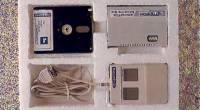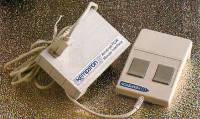Table of Contents
Kempston Mouse
This mouse manufactured by Kempston Data is a peripheral that provides the PCW with a mouse that makes the task easier with the use of programs , especially graphics, connecting through its rear interface.
Packaging
Images
Description
With the appearance of the mouse, the option selection system and everything related to the movement of the cursor on the screen ceased to be exclusively functions of the keyboard. Given the advantages of this new peripheral: convenience, ease and speed, the user opted for all the applications that had this add-on.
Actually, of the three elements that make up the system (interface, software and mouse) only the interface was produced by Kempston Data. To develop the software, the services of HiSoft were used, and the mouse itself is from Logitech, the Swiss brand known for the good finish of its products.
All this set is presented in a voluminous white cork box. The installation of the mouse is simple and fast.
First of all, the interface must be connected to the expansion port on the back of the machine (remember that any connection or disconnection to this slot must be done with the computer turned off), after this all that remains is to “click” the mouse to the nine-pin connector that incorporates the interface and activate it with the driver found on the mouse's own utilities disk.
In this disk, in addition to the mouse driver, there is a small program to check the proper functioning of the peripheral and some GSX drivers for graphics management. But let's go in parts.
The driver is resident and makes the mouse emulate the cursor movement keys and the ALT+C and ALT+R keys (left and right mouse button respectively). On the other hand, the sensitivity of the mouse is also given by this software, sensitivity that is expressed according to a gradation from two to nine, although the value given by default is four. All these parameters can be modified temporarily or permanently, that is, whether or not the new values are written to disk.
In this way it would be possible to make the mouse work with practically any program, since it would be enough to define the keys that the mouse emulates according to those used by the program in question. Although obviously this is not possible with direct boot software. In any case, it has been verified how certain software ignores the mouse, although it generates the same signal as the keys used by the program.
It is also worth talking about KTEST, the program that allows you to check the operation of the mouse. This software is not very useful, although it always comes in handy to set the degree of sensitivity of the mouse and know which keys it emulates.
Finally, the GSX drivers, which allow the mouse to work without major problems with all those applications that make use of this graphic extension of the CP/M. The installation process is somewhat more complex and, in a certain sense, specific to each program.
As for the hardware, it is made up of two things: the interface and the mouse itself. The interface is simply a white box with a connector for the expansion bus and a nine-pin output. Its interior could not be simpler, a plate with tracks on both sides and a series of chips, including some RAM.
The mouse, as has already been said, is from Logitech, with a detail that quickly surprises: its low weight. The mechanism is optical, that is, when the mouse moves, it turns two small wheels, with holes that cut light beams, which indicate to the computer what the mouse movements are. To detect if one of the two buttons has been pressed, the mouse uses two small switches.
At first, mice emerged as one more element within a whole way of understanding the man-machine relationship, they were the key piece of the so-called VIMP environments (windows, icons, mouse and pointer). Despite this, the advantages of using these input devices in other tasks have already been demonstrated over and over again. Although it is not very clear why a database or word processor user wants a mouse, it is very suitable for all kinds of graphical work, and this is where the subject of the GSX graphical extension becomes especially interesting.
It is, without a doubt, an interesting peripheral with multiple applications. The ease of adapting it for different programs makes it almost compatible with almost all existing software today. In addition, and this is very important, it is a product well made and supported by one of the greats in the world of the periphery.
Some of the programs that work with the Kempston Mouse are:
- Star Glider
- Wordstar
- SuperCalc 2
- Todo el software de Hisoft
- Cyrus II
- Cracker 2
- Data Fax
Extras
The Kempston Mouse interface uses three ports 208, 209 and 212 for its operation, with the following meanings:
| Dec | 208 | Hex | 0D0h | Concept | Mouse X coordinate |
|---|---|---|---|---|---|
| Dec | 209 | Hex | 0D1h | Concept | Mouse Y coordinate |
| Dec | 212 | Hex | 0D4h | Concept | Mouse button |
This mouse appears in ports 0D0h-0D4h:
- 0D0h gives the X position, 0-255. The same value can also be read from 0D2h.
- 0D1h gives the Y position, 0-255. The same value can also be read from 0D3h.
- 0D4h da el estado del botón en 2 bits. Cero si se pulsa el botón y 1 en los demás. El bit 0 es izquierda; el bit 1 es derecha. Los otros bits son 1.


